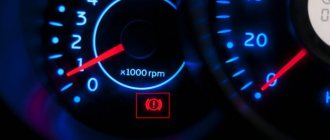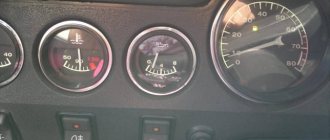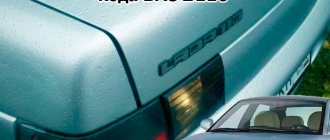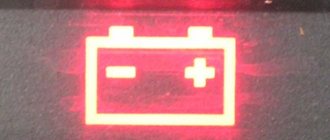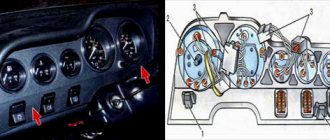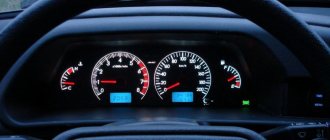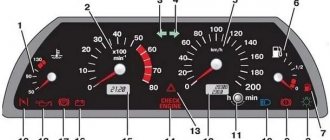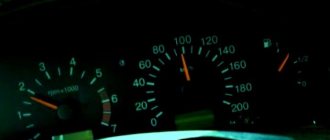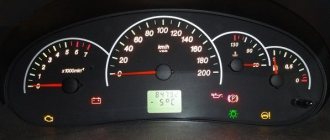- Dashboard indicator symbols
- The exclamation mark is on - what to do?
- In what cases is it necessary to remove the instrument panel?
Tachometer, speedometer, on-board computer indicators, light bulbs - all this is represented by the Priora instrument panel. The “tidy” is designed to display the current state of various Lada Priora systems. An experienced motorist will immediately notice that one of the components requires repair; a certain icon will inform him about this. If you are a novice driver, then it will be useful for you to study the Lada Priora dashboard. This material provides a detailed description of each element of the tidy.
An exclamation mark is lit on the dashboard: what should the driver do?
According to experts, faults in electronics can also cause indexing. Icons may appear involuntarily on the dashboard due to the following breakdowns:
- if the contacts succumb to the oxidation process;
- if the terminals change their location;
- if breakdowns occur in the on-board car computer.
Taking into account the advice of experts, and in order not to harm one of the car systems, you need to check the functionality of electronic components. To do this, you will need to diagnose the electronic part, which is done quite easily - remove the dashboard and check the location of the terminals in the so-called sockets.
As a rule, among the main icons it is customary to highlight the engine “check”, the Airbag icon in the form of a man fastened with a belt, the spiral of glow plugs for a diesel engine, the oil pressure drop indicator in the form of an oil can with a drop, as well as the engine overheating icon, which is usually made in the form of a thermometer with waves.
Also on many cars an important indicator is the exclamation mark. Normally, after starting the engine and performing self-diagnosis, all warning and emergency symbols should go out after a few seconds.
In some cases, if a malfunction occurs, in addition to the exclamation mark, icons on the car’s dashboard light up. In others, apart from this sign, nothing may light up. So, if the red icon (!) is lit on the panel, then this often indicates
problems with the brake system
.
Typically, this indicator lights up when the level of brake fluid in the reservoir drops significantly. This indicates that the system is not tight, which is unacceptable. It is not difficult to guess that such problems with brakes require immediate diagnosis. Moreover, operating a car with a glowing red exclamation mark on the dashboard in such a situation is prohibited!
However, the brakes may be fine, although the indicated error on the dashboard may be present. For this reason, you need to know why else the exclamation mark on the instrument panel may be on besides the low brake fluid level.
- If the sign is in a circle and parentheses, then it is brakes. In the case where the exclamation mark and the ABS sign are lit in parallel, the problem is usually a faulty ABS.
- If the exclamation point is in the yellow triangle, there is a malfunction in the electronic stabilization system.
- A red triangle with an exclamation mark may indicate various breakdowns and the need for diagnostics, that is, you need to carefully examine the instrument panel and see if any other icons are lit.
Please note that often the culprit for this indicator to light up may be a sensor failure, wiring problems or poor contacts. For example, the GTZ sensor connector on the master brake cylinder, broken wiring, damage or open circuit. The brake fluid level sensor may also be faulty. It also happens that problems arise with the instrument panel itself.
Taking into account the fact that there may be several reasons, with the brakes being the most serious, let us dwell on this problem in more detail. If the exclamation mark is on on the panel, the first step is to check the brake fluid level in the reservoir.
To do this, just put the car on a level surface, unscrew the tank cap and make sure that the level is between o and “max”. If the level is below the minimum mark, then the exclamation mark on the panel lights up based on a signal from the sensor.
In the case where the driver recently checked the level, and now there has been a sharp decrease, it is important to find the cause of the leakage of fuel fluid from the system. This could be brake hoses, hydraulic clutch, brake cylinders, etc.
It also happens that the indicator lights up while driving over bumps, and then goes out on a smooth road. This means that there is little liquid in the tank, but the level has not yet dropped to a critical level. When the car rocks, the sensor is triggered, while on a flat surface the level of brake fluid is still sufficient for the indicator to go out.
Icon for turning on external lighting devices (headlights)
A green or yellow indicator in the form of a crossed out lamp or a light bulb with an exclamation mark indicates a malfunction of one of the external lighting sources (low or high beam). If the element itself is intact, then the reason must be sought in the wiring or safety devices.
High beam in the car is activated
Automatic switching between low and high beams switched on
Yellow headlight direction icons indicate a malfunction in the functioning of the automatic headlight angle adjustment mechanism
A yellow indicator with the words “AFS OFF” indicates that the adaptive headlights mechanism is deactivated. If one of these icons blinks, it means that one of the devices is malfunctioning.
Green indicators in the form of a headlight or the inscription “DRL” appear when the system for automatically activating low-beam headlights is turned on during the daytime
The yellow icon in the form of a car with its optics turned on is associated with problems detected in the functioning of one or more brake light bulbs or taillights. If the lamps are working properly, the appearance of the indicator warns of damaged wiring or a broken relay fuse.
Green headlights indicate activation of side lighting sources. Icon of switched on fog lights
Two green arrows pointing in different directions indicate activation of the turn signal or light alarm
What to do if the lamp comes on?
- The first thing you need to do is check the fuel fluid level. This is done simply and without any difficulties. Open the hood and look at the level, it should be between the “MIN” and “MAX” marks. The level must be monitored constantly; for those who forget to do this, there is an exclamation mark. It lights up based on a signal from the sensor, which signals when the fuel level is below the permissible level.
By the way! There are often cases when the light comes on when driving over uneven surfaces and goes out as soon as the car drives onto a more or less level road. This happens precisely because the level of “brake fluid” is close to the “MIN” mark and while the car is rocking, the sensor detects a low level and signals this to the instrument panel.
- If everything is in order with the brake fluid level, you need to check the fuel injection system, which is located in the brake fluid tank. I'll tell you how to do this now.
2.1. Turn on the ignition and make sure that the exclamation mark lamp comes on, that is, the indicator of insufficient fuel level. It should light up and go out if the level is normal and the sensor is working.
2.2. We turn off the power from the sensor and look at the lamp; if it goes out, most likely there is a problem with the sensor. Check the sensor, sometimes the problem is that the float fails and sinks to the bottom even though the fuel fluid level is fine.
2.3. If, after turning off the power from the sensor, the exclamation mark on the panel continues to light, most likely the problem is in the wiring, and the sensor itself is working. Perhaps the reason is a short circuit in the wiring, or something else, but one way or another the problem will be associated with a faulty wiring and a violation of its integrity.
If everything is fine with your fuel oil level sensor, but you want to check its operation, this is done quite simply
2.4. We press the rubber seal on the tank lid, so you lower the sensor float to the bottom, and in working sensors an exclamation mark on the panel lights up.
2.5. If the indicator does not light up, take a small piece of copper wire and turn off the power from the brake fluid level sensor. The prepared wire must be used to close the power contacts of the sensor, that is, the contacts on the wiring that is supplied to the sensor, and not the contacts of the sensor itself. With such a short circuit, a corresponding signal about low brake fluid level should appear on the panel. If this does not happen, most likely the sensor is working, and the problem is faulty wiring.
If the brake fluid level sensor is faulty, replace it; if the problem is in the float of this sensor, you can try to repair it; if the wiring is faulty, replace it or seek help from an experienced auto electrician.
Tachometer, speedometer, on-board computer indicators, light bulbs - all these components are located on the Lada instrument panel. The “tidy” is designed to display the current state of various Lada Priora systems. An experienced motorist will immediately notice that one of the components requires repair; a certain icon will inform him about this. If you are a novice driver, then it will be useful for you to study the Lada Priora dashboard. This material provides a detailed description of each element of the tidy.
Warning icons on the panel
The steering wheel icon can light up in two colors. If the yellow steering wheel is on, then adaptation is required, and when a red image of the steering wheel with an exclamation mark appears, you should already be concerned about the failure of the power steering or power steering system. When the red steering wheel lights up, your steering wheel will probably become very difficult to turn.
The immobilizer icon usually blinks if the car is locked; in this case, the indicator of a red car with a white key signals the operation of the anti-theft system. But there are 3 main reasons if the immo light is constantly on: the immobilizer is not activated, if the tag on the key is not read or the anti-theft system is faulty.
The handbrake icon lights up not only when the handbrake lever is activated (raised), but also in cases where the brake pads are worn out or the brake fluid needs to be topped up/replaced. On a car with an electronic handbrake, the parking brake light may come on due to a glitch in the limit switch or sensor.
The coolant icon has several options and depending on which one is lit, draw conclusions about the problem accordingly. One red lamp with a thermometer scale indicates an increased temperature in the engine cooling system, but a yellow expansion tank with waves indicates a low coolant level in the system.
The washer icon indicates a low fluid level in the windshield washer reservoir. Such an indicator lights up not only when the level actually decreases, but also if the level sensor is clogged (the sensor contacts become coated due to poor-quality liquid), giving a false signal. On some vehicles, the level sensor is triggered when the washer fluid does not meet specifications.
The ASR icon is an Anti-Spin Regulation indicator. The electronic unit of this system works in tandem with ABS sensors. When such a light is constantly on, it means the ASR is not working. On different cars, such an icon may look different, but often in the form of an exclamation mark in a triangle with an arrow around it or the inscription itself, or in the form of a car on a slippery road.
The catalyst icon often lights up when the catalytic element overheats and is quite often accompanied by a sharp drop in engine power. Such overheating can occur not only due to poor cell throughput, but also if problems arise in the ignition system. When the catalyst fails, high fuel consumption will be added to the burning light.
The exhaust gases icon, according to information from the manual, indicates a malfunction in the exhaust gas purification system, but, as a rule, such a light starts to light after poor refueling or the presence of an error in the lambda probe sensor. The system registers misfires of the mixture, as a result of which the content of harmful substances in the exhaust gases increases and, as a result, the “exhaust gases” light comes on on the dashboard. The problem is not critical, but diagnostics are worth doing to find out the cause.
Fuse box
The weak link of the electric power steering on Kalina is the fuse box; if something doesn’t work, it’s worth checking them.
To get to them, you need to open the dashboard, to the left of the steering wheel. To do this, pull the top part towards you and the latch will open. Check if the fuse is working, if it fails, replace it. It is very easy to check, check the integrity of the thread inside the fuse. Changing a 50 amp relay to a 30 amp one will also help.
Newer versions of Kalina are equipped with electric amplifiers from Hyundai, which has a positive effect on its reliability. However, there are still thousands of cars with the domestic version, which malfunctions and breaks down from time to time. Now it will be easier for you to repair the electric power steering on Kalina yourself. The main thing to remember is that not every amplifier shutdown is a breakdown. And you can find the problem yourself and fix it, but somewhere you will have to go to a service center.
- Lada Priora: main problems of electric power steering and their elimination
- How to determine that the EUR needs repair
- Main malfunctions of electric power steering and their causes
- How to repair the EUR yourself
- EUR for Lada Priora: faults and solutions
- Operating rules for electric power steering, extending the life of the power steering
One of the most problematic areas of the Lada Priora is the electric power steering. That is why repairing electric power steering is a common problem faced by Priora owners. If you find that the EUR on the Priora does not work, then immediately contact a specialist or do the repairs yourself. Most often, the electric power steering of the Priora has two causes of malfunction.
How to determine that the EUR needs repair
The electric booster on the Priora does not work very often. It refuses to work on both new and used cars.
If a problem occurs with the electric power steering, a yellow button on the dashboard lights up, with a steering wheel with an exclamation mark on it. This button notifies you of malfunctions or failure of the electric power steering.
You can drive the car without the help of an electric booster. To do this, you just need to pull out the power steering fuse, which is located to the left of the steering wheel. Malfunctions of the EUR on a Priora should not scare you, since this malfunction can be eliminated even on your own.
Main malfunctions of electric power steering and their causes
The electric power steering on a Priora fails for the following reasons:
1.When the ignition is turned on, the ESD does not undergo self-monitoring and turns itself off so as not to interfere with the driver and not create an emergency situation on the road. In this case, repairs will be expensive.
2. The electric power steering on the Priora does not work due to a malfunction of the speed sensor. The EUR scans the vehicle's speed from the speedometer, which receives data from the speed sensor. When a sensor breaks down, it begins to provide incorrect information. Then the EUR turns off spontaneously, since it does not know the exact speed of the car. In this case, repair of the electric amplifier is carried out by replacing the sensor.
If the electric power steering on a Priora does not work, a flashing error on the dashboard will immediately let you know.
How to repair the EUR yourself
The electric power steering of the Priora has several causes of malfunction and one way to solve them. For repair you will need:
- Head for 8 and 13 mm
- Ratchet or crank
- Extension
- Hammer
- Chisel
Reporting a malfunction
The battery icon lights up if the voltage in the on-board network drops; often this problem is associated with a lack of battery charge from the generator, so it can also be called the “alternator icon”. On vehicles with a hybrid engine, this indicator is supplemented by the inscription “MAIN” at the bottom.
The oil icon, also known as a red oil can, indicates a drop in the oil level in the car engine. This icon lights up when you start the engine, and does not go out after a few seconds or may light up while driving. This fact indicates problems in the lubrication system or a drop in oil level or pressure.
The airbag icon can light up in several ways: either the red inscription SRS and AIRBAG, or “a red man wearing a seat belt,” with a circle in front of him. When one of these airbag icons lights up on the panel, the on-board computer notifies you of a malfunction in the passive safety system, and in the event of an accident, the airbags will not deploy.
The handbrake is up, the brake pads are worn out or the brake fluid level is low. A low level is precisely what poses a danger, because the reason may not only be in heavily worn pads, as a result of which, when you press the pedal, the fluid disperses throughout the system, and the float gives a signal about a low level, the brake hose may be damaged somewhere, and this is much more serious.
An exclamation mark can also light up in the form of an “attention” sign, both on a red and yellow background. When the yellow “attention” sign lights up, it informs about a malfunction in the electronic stabilization system, and if it is on a red background, it simply warns the driver about something, and, as a rule, explanatory text is displayed on the dashboard display or combined with other informative text designation.
The ABS icon may have several display options on the dashboard, but regardless of this, it means the same thing on all cars - a problem has occurred in the ABS system, and that the anti-lock wheel system is not working at the moment. You can find out the reasons why ABS does not work in our article. In this case, movement can be made, but there is no need to rely on the ABS to activate; the brakes will operate as usual.
The ESP icon may either light up intermittently or stay on constantly. A light with this inscription indicates problems with the stabilization system. The Electronic Stability Program indicator, as a rule, lights up for one of two reasons - either the rotation angle sensor has failed, or the brake light sensor (aka “frog”) has died for a long time. Although, there can be a more serious problem, for example, the brake system pressure sensor is covered.
The engine icon, some drivers may call it the “injector icon” or check, may glow yellow when the engine is running. It informs about the presence of engine errors and malfunctions of its electronic systems. To determine the reason for its appearance on the dashboard display, self-diagnosis or computer diagnostics are performed.
The glow plug icon may light up on the dashboard of a diesel car; the meaning of such an indicator is exactly the same as the “check” icon on gasoline cars. When there are no errors in the electronic unit’s memory, the spiral icon should go out after the engine warms up and the glow plugs are turned off. Read how to check glow plugs here.
This material is informative for most car owners. And although absolutely all possible icons of all existing cars are not presented here, you will be able to independently understand the main symbols of the car’s dashboard, and will not sound the alarm when you see that the icon on the panel is on again.
Panel malfunctions: signs and causes
What malfunctions can occur in the operation of the control panel:
- The backlight does not light up. There may be several reasons - damage to the device’s power supply circuit, a short circuit in the system, failure of the control panel. But one of the most common reasons in this case is the burnout of the safety device. The marking fuse F10 is located in the mounting block; it must be checked first.
- The sensors do not work - the arrows on the speedometer and tachometer do not rise. The reason may be a bad signal coming from the speed sensor or crankshaft sensor to the dashboard. It is necessary to check the electrical circuit for breaks. Much less often the problem lies in a failed sensor.
- The controller for the volume of gasoline in the tank and the engine temperature do not work. As in the previous case, the cause of the malfunction may lie directly in the sensors themselves. The fuel volume controller is located in the tank with the fuel pump, and the coolant sensor is located in the cylinder head. Before replacing, we recommend checking the quality of the connection and contacts - perhaps they are simply damaged or oxidized, as a result of which the sensors do not work. The reason may also be a damaged electrical circuit; in this case, you will need to check the wiring.
- It happens that the dashboard as a whole works correctly, but the controllers transmit incorrect information. The reason may lie in the performance of the processor or a short circuit in the wiring. Sometimes the problem lies in bad mass.
- The backlight is partially not working. Most likely, the reason lies in the burnout of the lighting sources; they will need to be replaced (the author of the video is the channel In Sandro’s Garage).
An exclamation mark lights up on the dashboard: what actions should car owners take?
Having ruled out a low level of fuel fluid, in the process of identifying a problematic element (sensor or wiring), you can quickly check the operation of the sensor and wiring right on the spot. It's not difficult to do this. It is enough to press the rubber seal of the tank lid, thereby lowering the sensor float. If the sensor is working properly, the exclamation mark on the panel should light up.
If the indicator does not light, then it is enough to take a small piece of copper wire, remove the power from the brake fluid level sensor and close the sensor power contacts on the wiring with the prepared wire. After the circuit closes, the low brake fluid level signal should light up. If the icon is not lit, there is a high probability of problems with the wiring.
Before you begin troubleshooting problems indicated by an exclamation mark that lights up on the instrument panel in a Priora, you should determine:
- where will it light up?
- what the icon will represent.
An icon can have multiple images:
- If a red exclamation mark starts to burn at the bottom of the circle, this will indicate a problem with the brake system, namely the minimum level of brake fluid. This problem can be solved quite simply by adding brake fluid to a special reservoir to the required level. If after this the indicator light continues to light, then experts advise checking the serviceability of all components of the brake system.
- If a red exclamation mark starts to light up in the triangle at the top of the circle on the Priora’s instrument panel, this will indicate a problem with the car’s brake force distributor. It is worth noting that the most modern models use not a circle, but a triangle. Only experienced specialists can fix this problem, so you need to visit a service station as soon as possible. And when driving, if you see that the light in the triangle has begun to light, you should be extremely careful.
- If the red exclamation mark, located at the bottom of the steering wheel icon, stays on for a long time, this will indicate a malfunction in the EPS (electric power steering wheel).
If the car owner sees that the light comes on while the engine is running, then first of all you need to check the functionality of the car's brake force distributor.
In what cases is it necessary to remove the instrument panel?
Dismantling the Priora tidy is required for tuning or replacing burnt out lamps. The VAZ 2170 is a modern model, so there are not many fastenings on the panel. To disassemble you will need a set of screwdrivers. Don't forget to turn off the negative battery.
- The process begins with removing the mounting block. To do this, you need to turn the latches on the fuse cover and then remove it;
Online magazine about car repair and operation
- Home /
- Questions and answers /
- Body and interior /
- Icons on the Priora dashboard
Let's sum it up
As you can see, the exclamation mark (!) on the instrument panel is lit for various reasons. Taking into account the fact that on different cars such an indicator can light up in different colors (yellow or red), it is important to be able to accurately determine the cause.
https://www.youtube.com/watch?v=qBViROjeqJU
In most cases, a similar red icon in a circle means that there are problems with the brake system. The yellow color may indicate wear on the brake pads, that is, the icon of this color is informational.
In any case, the brake system in such a situation and regardless of the color of the indicator needs diagnostics. If necessary, maintenance or repairs are performed. If the reason for the indicator to light up is a malfunction of the brake fluid level sensor, the sensor needs to be replaced. By the way, on many cars you can only replace the float if it is the problem.
Information icons
The machine icon may light up differently; it happens that the “car with a wrench” icon, the “car with a lock” icon, or an exclamation mark are lit. About all these notations in order:
When such an indicator lights up (a car with a key), it informs about malfunctions in the engine (often a malfunction of some sensor) or the electronic part of the transmission. To find out the exact cause, you will need to perform diagnostics.
A red car with a lock lights up, which means that there are problems in the operation of the standard anti-theft system and it will be impossible to start the car, but if this icon blinks when the car is locked, then everything is normal - the car is locked.
A yellow vehicle indicator with an exclamation mark notifies the driver of a hybrid vehicle that there is a problem with the electric drive. Resetting the error by disconnecting the battery terminal will not solve the problem - diagnostics are needed.
Everyone is used to seeing the open door icon lit when a door or trunk lid is open, but if all the doors are closed and the light on one or four doors continues to shine, then often the problem should be looked for in the door terminals (wire contacts).
The slippery road icon begins to flash when the stability control system detects a section of slippery road and is activated to prevent slipping by reducing engine power and braking the slipping wheel. There is no need to worry in such a situation. But when a key, a triangle, or a crossed out skid icon appears near such an indicator, the stabilization system is faulty.
The wrench icon pops up on the display when it’s time to perform vehicle maintenance. It is an information indicator and is reset after maintenance.
Reasons for low level
A low brake fluid level may occur due to a brake fluid leak. It is necessary to check the entire brake system for leaks; if any are found, fix them immediately.
It should also be noted that low fluid levels can be observed due to worn brake pads. This is explained by the fact that the thickness of the pad becomes smaller and the caliper piston extends further, therefore, the fluid level in the reservoir decreases. After replacing the pads, the level will be restored to its original position.
If the pads in your car are worn out, you can read how to replace them yourself here.
Non-mechanical reasons for the indicator to turn on
If everything is in order with the car, there are no leaks and the pads are normal, then most likely the reason is in the electrical wiring or the brake fluid level sensor.
Source
Methods for determining EUR malfunction
Well, of course, the first sign of a breakdown in the system is the activation of the ECU warning light on the instrument panel. Usually on a standard one, this is an icon in the shape of a steering wheel with an exclamation mark. When you turn on the ignition, it lights up for a few seconds, and then, if the computer decides that everything is in order, the light goes out. And accordingly, when a breakdown of the Priora’s electric amplifier is detected, it lights up and remains on.
So, carry out computer diagnostics, contact the ECU, get error codes with or without decoding. Even if the scanner only produces codes, it’s not scary. You can just know that faults associated with the Priora ESD begin with the symbol “C”. For example, C1013, means that the voltage in the network is low, and this is not enough for the electric amplifier.
Well, there may be several options. The most common case is the weakening or burning of one of the two power wires going to the EUR. These are red and black wires, large cross-section, included in a separate connector on the device. They are quite easy to check. It could also be a large fuse for the device, everything is clear here. Well, the third reason is a deficiency in the car’s network, for example, a weak or faulty battery or generator. In case of such a malfunction, contact a specialist, and nothing else. To an auto electrician.
“Folk” method of checking a malfunction, or “control”
Well, if the indicator does not light up, and there are doubts about the serviceability or malfunctions of the Priora ESD, or after repairs you need to do a “check,” proceed as follows: you need to turn the steering wheel without turning on the ignition. Remember the effort. And repeat the operation by starting the engine. If there are no changes, something happened to the Priora EUR!
What malfunctions exist in the Priora electric booster?
And again the same list, mechanics, electrical, electronics. Well, everything is clear with mechanics, this is a failure of shafts, connections and fittings. With this malfunction, the wheels simply will not respond to the steering wheel turning. And this problem is easiest to fix. But with other faults it is much more complicated. If the malfunctions are related to the failure of the servomotor, amplifier, or Priora itself, there is no point in thinking about repairs. It’s easier to buy a new EUR at the store and replace it yourself. Or take it to a service center and try to repair it there. If the connection with the Priora ESD ECU is lost, then this is most likely the second connector, with a trail of wires, the same is true if the unit does not receive a signal from external sensors - the crankshaft and camshaft. Yes, yes, they are also important for the operation of the device. In these cases, an inexpensive bundle of wires can be removed and repaired, or replaced.
What remains is the “brain” of the electric amplifier, and the internal position sensors of the unit’s shafts. Messing with sensors is not an option, only repair service. But the computer itself, if it malfunctions, you can buy and replace yourself.
What does it mean
This sign informs the driver that the brake fluid level is low. If it is detected on the panel, it is recommended to immediately stop and check the brake fluid level in the reservoir. It must be no lower than the MIN mark; otherwise, it is recommended to top up the fuel fluid and check the brake line for fluid leaks.
TJ has good fluidity and is able to seep where water will not leak. Continuing to drive with leaking brake fluid is unsafe and PROHIBITED!
During normal operation of all elements of the car, the indicator lamps light up when the ignition is turned on; as soon as the engine starts, all indicators should go out.
